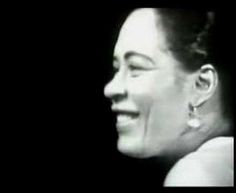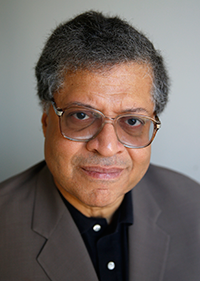Each of us who loves Billie Holiday in all her mercurial variations favors the one we saw first. For me, it was a clip from the TV recital she gave in 1957 for the nonpareil CBS special, “The Sound of Jazz.” It was the kind of show my parents would have watched attentively with their friends in our living room if only because there were so few TV shows of any kind in those primordial days that featured so many black people in one place playing music. And I was the kind of five-year-old who’d have stopped and stared at it while all the grownups alternately chattered and listened. But I don’t remember much about the show’s first telecast and didn’t see Holiday’s performance until ten years later when her segment was excerpted on some black history special on the same network. And what I saw, however fleeting, haunted me forever.
For starters, I never heard a voice like hers before – and this was about the time that, according to conventional wisdom, that voice was less powerful, less robust and more frayed than it had been in its earlier bloom. It still sounded special to me; so much so, that I couldn’t find the words to characterize it. Even now, I feel myself groping for adjectives like “sultry,” “pliant,” or even “delicately spiced.” (Wince.) With any force of nature, to describe is to diminish its power.
Yet the voice was for me the least of it at that moment. What hit me in a deeper place was what my older, wiser self would now call her sang-froid. The composure, regal and raw, was a compound I’d seen before in dozens of singers, black and white, old and young, male and female. But never before had I been aware that such commanding presence could be as inscrutable as the main character in a mystery story; a master thief, say, blithely slipping into a dark alley concealing gilded swag, or a cynical detective who’d stumbled onto a solution she wished she hadn’t, but wasn’t going to let its horror trip her up — or keep rough justice at bay. She was fire and ice, calibrated with a perfection that I’d dimly suspected was harder to achieve than it looked.
And by “harder,” I am not speaking of the legendary tribulations of Holiday’s life. For too long, her heartbreak and (sometimes self-inflected) pain have been placed at the center of her story at the expense of her craft. Her 1956 memoir, Lady Sings the Blues, provided the lens through which people continue to view Holiday’s life and work, even if the intervening years have disclosed many flaws and inaccuracies, beginning with its memorable first sentence. I now believe that book has a lot in common with her rendition of a pop standard. They share many of the same attributes: dramatic timing, pungent lyricism and rueful wit coated with honey and bitters. Others may have used her music to wallow in their own sadness. She did not. The troubles were tools in her paint box along with all the other things at her disposal.
In this centennial year of Eleanora Fagan’s birth, this view has, I think, become the prevailing one, thanks in large part to biographies written over the decades by Robert O’Meally, Farah Jasmine Griffin and now John Szwed, whose just-published Billie Holiday: The Musician and the Myth (Viking) provides a fresh template for evaluating the elements of Holiday’s musicianship and, more important, how her enduring influence on generations of singers (beginning with Frank Sinatra, who also has a 100th birthday coming up this year) has less to do with her personal life than with her way of bending lyrics, expanding space and marking time.
I`d rather hear her now. She`s become more mature. Sometimes you can sing words every night for five years, and all of a sudden it dawns on you what the song means. I played ‘My Funny Valentine’ for a long time – and didn’t like it – and all of a sudden it meant something. So with Billie, you know she’s not thinking now what she was in 1937, and she’s probably learned more about different things. And she still has control, probably more control now than she did back then. No, I don’t think she’s in decline.
“She sings way behind the beat and then brings it up – hitting right on the beat. You can play behind the beat, but every once in a while you have to cut into the rhythm section on a beat and that keeps everybody together. Sinatra does it by accenting a word. A lot of singers try to sing like Billie, but just the act of playing behind the beat doesn’t make it sound soulful.
“I don’t think that guys like Buck Clayton are the best possible accompanists for her. I’d rather hear her with Bobby Tucker, the pianist she used to have. She doesn’t need any horns. She sounds like one anyway.”
— MILES DAVIS ON BILLIE HOLIDAY, Jazz Review interview, 1958
I’m with Miles on this. I always have been. One’s first Billie, as I said earlier, is one’s best Billie. And it was with the later, presumably less vital Billie that I fell in love. For those like Nat Hentoff, with whom Davis was giving the interview, the younger, more buoyant Billie Holiday who broke into public consciousness in the mid-1930s singing with the likes of Benny Goodman, Teddy Wilson, and, most especially, her musical soul mate Lester Young, was the best by far. And I get that. The Columbia recordings from that period attest to a sense of joy and discovery in Holiday’s singing that burst through even the tiniest reproductions of “What a Little Moonlight Can Do” or “I’ll Never Be The Same.”
As she became older and life got tougher, the joy receded and something more acerbic and world-weary crept into her singing. Yet I now believe what many regarded as decline was more like adjustment, realignment and even growth. Cops and cabaret owners may have pummeled the swagger out of her. But in all her performances, including her book, Holiday never came across as someone who took shit indefinitely. The struggle toughened her. That’s what struggle tends to do. And she used what she learned to get a better handle on what she was doing. The worse it got, the better she got. That’s what Miles Davis was talking about. It’s how I prefer to think of her, whether she’s deep in thought listening to a playback, as in Milt Hinton’s mesmerizing photographs from the 1958 Lady in Satin sessions or making her way through an especially tricky passage across a song’s bridge.
And the joy never really went away. Look again at that clip from “Sound of Jazz.” Notice how her head shakes when she’s listening to the other musicians and how her eyes shimmer as each soloist cruises by. And When her once-beloved Prez steps to the plate and blows what I and many others believe to be his last great solo, her face glows brightest, the years fall away and you could swear you can feel the same energy she had in her 20s when everything that happened to her, good and bad, was still ahead.


